Related Research Articles

Ravenloft is a campaign setting for the Dungeons & Dragons roleplaying game. It is an alternate time-space existence known as a pocket dimension or demiplane, called the Demiplane of Dread, which consists of a collection of land pieces called "domains", brought together by a mysterious force known only as the Dark Powers. Each domain is tailored to and mystically ruled by a being called a Darklord who is forever trapped and surrounded by magical mists surrounding the domain. Strahd von Zarovich, a vampire in the original AD&DRavenloft I6 module 1983, became the first Darklord, both ruler and prisoner of his own personal domain of Barovia. How Count von Zarovich became the darklord of Barovia was detailed in the novel I, Strahd: The Memoirs of a Vampire. As originally established in the Ravenloft: Realm of Terror boxed set known as "the Black Box" released in 1990, the Ravenloft campaign setting was located in the Ethereal Plane. As a physical manifestation of that plane, lands, monsters and even people were created out of the mysterious mists, and the realm acted as a prison where one could enter or be transported, but means of escape were few. Other Ravenloft Domains and Darklords were eventually added in various AD&D 2nd edition products establishing a core continent attached around Barovia which could be traveled to by others if their respective lords allowed entering or leaving their borders; while some Domains remained isolated in the mists and were referred to as Islands.

The Monstrous Compendium is a series of accessories for the Advanced Dungeons & Dragons fantasy role-playing game released from 1989 to 1998. The title was then used for a series of 5th Edition Dungeons & Dragons supplements released on D&D Beyond.

Count Strahd von Zarovich is a fictional character originally appearing as the feature villain in the highly popular Advanced Dungeons and Dragons adventure module I6: Ravenloft. Later, this character and his world would be explored in follow-up modules, novels, and the Ravenloft campaign setting. Within this setting, Strahd is the first and best-known of Ravenloft's darklords. He is a powerful ancient vampire. He is also a master necromancer, a skilled warrior, and the unquestioned ruler of the domain of Barovia.
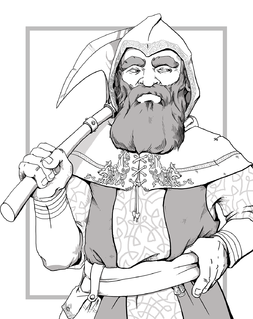
A dwarf, in the Dungeons & Dragons (D&D) fantasy roleplaying game, is a humanoid race, one of the primary races available for player characters. The idea for the D&D dwarf comes from the dwarves of European mythologies and J. R. R. Tolkien's novel The Lord of the Rings (1954-1955), and has been used in D&D and its predecessor Chainmail since the early 1970s. Variations from the standard dwarf archetype of a short and stout demihuman are commonly called subraces, of which there are more than a dozen across many different rule sets and campaign settings.
The flexibility of the Dungeons & Dragons (D&D) game rules means that Dungeon Masters (DM) are free to create their own fantasy campaign settings. For those who wanted a pre-packaged setting in which to play, TSR, Wizards of the Coast (WotC), and other publishers have created many settings in which D&D games can be based; of these, the Forgotten Realms, an epic fantasy world, has been one of the most successful and critically acclaimed settings. Many campaign settings include standard sword and sorcery environments, while others borrow Asian, Central American, swashbuckling, horror and even space-travel themes.
James Daniel Lowder is an American author and editor, working regularly within the fantasy, dark fantasy, and horror genres, and on tabletop role-playing games and critical works exploring popular culture.

The elf is a humanoid race in the Dungeons & Dragons fantasy role-playing game, one of the primary races available for player characters, and play a central role in the narratives of many setting worlds of the game. Elves are renowned for their grace and mastery of magic and weapons such as the bow and sword. Becoming physically mature by the age of 25 and emotionally mature at around 125, they are also famously long-lived, capable of living more than half a millennium and remaining physically youthful. Possessed of innate beauty and easy gracefulness, they are viewed as both wondrous and haughty by other races; however, their natural detachment is seen by some as introversion or xenophobia. They were usually antagonistic towards dwarves.
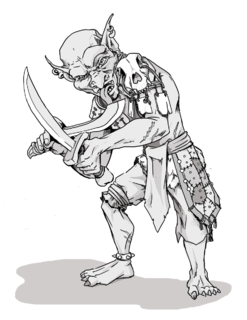
In the Dungeons & Dragons fantasy role-playing game, goblins are a common and fairly weak race of evil humanoid monsters. Goblins are non-human monsters that low-level player characters often face in combat.
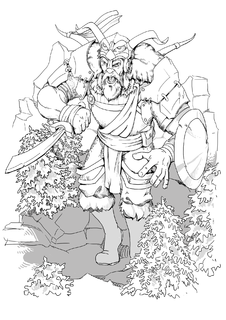
In the Dungeons & Dragons fantasy role-playing game, giants are a collection of very large humanoid creatures based on giants of legend, or in third edition, a "creature type".
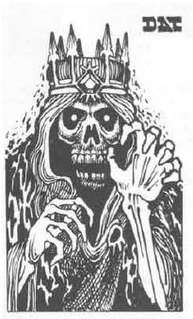
The lich is an undead creature found in the Dungeons & Dragons (D&D) fantasy role-playing game. Liches are spellcasters who seek to defy death by magical means.
In the Dungeons & Dragons fantasy role-playing game, a vampire is an undead creature. A humanoid or monstrous humanoid creature can become a vampire, and looks as it did in life, with pale skin, haunting red eyes, and a feral cast to its features. A new vampire is created when another vampire drains the life out of a living creature. Its depiction is related to those in the 1930s and 1940s Hollywood Dracula and monster movies. In writing vampires into the game, as with other creatures arising in folklore, the authors had to consider what elements arising in more recent popular culture should be incorporated into their description and characteristics.
Tritons are a fictional species in the Dungeons & Dragons fantasy role-playing game.
Nigel D. Findley was a Canadian game designer, editor, and an author of science fiction and fantasy novels and role-playing games (RPGs).
Anne K. Brown is a writer and editor in the role-playing game industry.

Bruce Nesmith is a game designer who has worked primarily on role-playing games. He was Creative Director at TSR, working on a variety of games including Dungeons & Dragons, and is a senior game designer at Bethesda Game Studios, where he has worked on AAA titles such as Fallout 3, Fallout 4 and Elder Scrolls IV: Oblivion, and was lead designer on Elder Scrolls V: Skyrim.
Rick Swan is a game designer and author who worked for TSR. His work for TSR, mostly for Advanced Dungeons & Dragons, appeared from 1989 to 1995.
Dale A. Donovan is a game designer who has worked primarily on role-playing games.
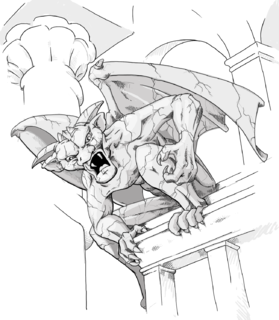
The gargoyle is a fantasy and horror monster inspired by the gargoyle architectural element. While they were believed in mythology to frighten away evil spirits, the idea of such statues physically coming to life is a more recent notion. Like golems, they are usually made of magically animated or transformed stone, but have animal or chimera traits and are often guardians of a place such as a cathedral or castle. They can also be depicted as vessels for demonic possession or as a living species resembling statues.
References
- 1 2 3 4 Connors, William W. (2007). "Dynasty League Baseball". In Lowder, James (ed.). Hobby Games: The 100 Best . Green Ronin Publishing. pp. 90–93. ISBN 978-1-932442-96-0.